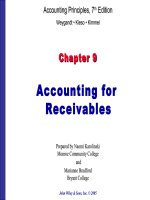Accounting principles 11e kieso kimmel chapter 001
Bạn đang xem bản rút gọn của tài liệu. Xem và tải ngay bản đầy đủ của tài liệu tại đây (2.2 MB, 61 trang )
Prepared by
Coby Harmon
University of California, Santa Barbara
Westmont College
1-1
1
Accounting in Action
Learning Objectives
After studying this chapter, you should be able to:
[1] Explain what accounting is.
[2] Identify the users and uses of accounting.
[3] Understand why ethics is a fundamental business concept.
[4] Explain generally accepted accounting principles.
[5] Explain the monetary unit assumption and the economic entity
assumption.
[6] State the accounting equation, and define its components.
[7] Analyze the effects of business transactions on the accounting equation.
[8] Understand the four financial statements and how they are prepared.
1-2
Preview of Chapter 1
Accounting Principles
Eleventh Edition
Weygandt Kimmel Kieso
1-3
What is Accounting?
Purpose of accounting is to:
1. identify,
2. record, and
3. communicate
the economic events of an organization to interested users.
1-4
LO 1 Explain what accounting is.
What is Accounting?
Three Activities
Illustration 1-1
Accounting process
The accounting process includes
the bookkeeping function.
1-5
LO 1 Explain what accounting is.
Who Uses Accounting Data
Internal
Users
Illustration 1-2
Questions that internal
users ask
1-6
LO 2
1-7
Who Uses Accounting Data
External
Users
1-8
Illustration 1-3
Questions that external
users ask
LO 2
The Building Blocks of Accounting
Ethics In Financial Reporting
United States regulators and lawmakers were very concerned
that the economy would suffer if investors lost confidence in
corporate accounting because of unethical financial reporting.
1-9
Recent financial scandals include: Enron, WorldCom,
HealthSouth, AIG, and others.
Congress passed Sarbanes-Oxley Act of (SOX) 2002.
Effective financial reporting depends on sound ethical
behavior.
LO 3 Understand why ethics is a fundamental business concept.
The Building Blocks of Accounting
Ethics In Financial Reporting
1-10
Illustration 1-4
Steps in analyzing ethics cases
and situations
LO 3 Understand why ethics is a fundamental business concept.
1-11
Ethics in Financial Reporting
Question
Ethics are the standards of conduct by which one's actions
are judged as:
a. right or wrong.
b. honest or dishonest.
c. fair or not fair.
d. all of these options.
1-12
LO 3 Understand why ethics is a fundamental business concept.
Generally Accepted Accounting Principles
Financial Statements
Various users
need financial
information
Balance Sheet
Income Statement
Statement of Owner’s Equity
Statement of Cash Flows
Note Disclosure
The accounting profession
has attempted to develop a
set of standards that are
generally accepted and
universally practiced.
1-13
Generally Accepted
Accounting
Principles (GAAP)
LO 4 Explain generally accepted accounting principles.
Generally Accepted Accounting Principles
Generally Accepted Accounting Principles (GAAP) - A set of
rules and practices, having substantial authoritative support, that
the accounting profession recognizes as a general guide for
financial reporting purposes.
Standard-setting bodies:
1-14
►
Securities and Exchange Commission
(SEC)
►
Financial Accounting Standards
Board (FASB)
►
International Accounting Standards
Board (IASB)
LO 4 Explain generally accepted accounting principles.
Generally Accepted Accounting Principles
Measurement Principles
Historical Cost Principle (or cost principle) dictates that
companies record assets at their cost.
Fair Value Principle states that assets and liabilities should
be reported at fair value (the price received to sell an asset or
settle a liability).
Selection of which principle to follow
generally relates to trade-offs
between relevance and faithful
representation.
1-15
LO 4 Explain generally accepted accounting principles.
1-16
Generally Accepted Accounting Principles
Assumptions
Monetary Unit Assumption requires that companies
include in the accounting records only transaction data that can be
expressed in terms of money.
Economic Entity Assumption
requires that activities of the entity be
kept separate and distinct from the
activities of its owner and all other
economic entities.
1-17
LO 5 Explain the monetary unit assumption
and the economic entity assumption.
Forms of Business Ownership
Proprietorship
Generally owned
by one person.
Owned by two or
more persons.
Often small
service-type
businesses
Often retail and
service-type
businesses
Owner receives
any profits,
suffers any
losses, and is
personally liable
for all debts.
1-18
Partnership
Generally
unlimited
personal liability
Corporation
Ownership
divided into
shares of stock
Separate legal
entity organized
under state
corporation law
Limited liability
Partnership
agreement
LO 5 Explain the monetary unit assumption
and the economic entity assumption.
Generally Accepted Accounting Principles
Question
Combining the activities of Kellogg and General Mills would
violate the
a. cost principle.
b. economic entity assumption.
c. monetary unit assumption.
d. ethics principle.
1-19
LO 5 Explain the monetary unit assumption
and the economic entity assumption.
Generally Accepted Accounting Principles
Question
A business organized as a separate legal entity under state law
having ownership divided into shares of stock is a
a. proprietorship.
b. partnership.
c. corporation.
d. sole proprietorship.
1-20
LO 5 Explain the monetary unit assumption
and the economic entity assumption.
1-21
The Basic Accounting Equation
Assets
=
Liabilities
+
Owner’s
Equity
Provides the underlying framework for recording and
summarizing economic events.
Assets are claimed by either creditors or owners.
Claims of creditors must be paid before ownership claims.
1-22
LO 6 State the accounting equation, and define its components.
The Basic Accounting Equation
Assets
Resources a business owns.
Provide future services or benefits.
Cash, Supplies, Equipment, etc.
Assets
1-23
=
Liabilities
+
Owner’s
Equity
LO 6 State the accounting equation, and define its components.
The Basic Accounting Equation
Liabilities
Claims against assets (debts and obligations).
Creditors - party to whom money is owed.
Accounts payable, Notes payable, etc.
Assets
1-24
=
Liabilities
+
Owner’s
Equity
LO 6 State the accounting equation, and define its components.
The Basic Accounting Equation
Owner’s Equity
Ownership claim on total assets.
Referred to as residual equity.
Investment by owners and revenues (+)
Drawings and expenses (-).
Assets
1-25
=
Liabilities
+
Owner’s
Equity
LO 6 State the accounting equation, and define its components.









